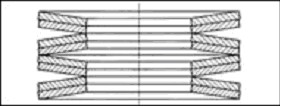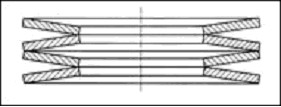The Disc Springs DIN 2093 work in axial compression force.
Its geometry is determinate by the values of: external diameter, internal diameter, thickness and height of the disc without load.
Its elasticity will depend on the dimensions shown and the elasticity module of the material selected for the application. The equations for its calculation are set in DIN 2092 standard.
On the other hand, Din 2093 standard defines the manufacture and characteristics of disc springs. Here we can see the standard:
Through mount configurations, the same spring allows us to assemble sets of different lengths that will also have different elastic constants. In this way we can adjust the stack to our necessities without big changes. Here below are the most used configurations:
A stack can be configured as a Parallel-serial combination.

The features of a serial stack are: Total Force of the Stack is the same to the Force that an individual spring can generate. On the other hand, the displacement of the stack is the displacement of one of the springs that form it, multiplied by the quantity of springs used in the stack.
F total = F individual
S total = i x S
Lo = i x lo
In the case of parallel stack, the other way around ; the displacement of the springs assembly is equivalent to the individual spring and the force is Multiplied by the quantity of springs .
F total = n x F individual
S total = S
Lo = lo + (n-1) x t
If the displacement is Serial – Parallel is determined by the next equations:
F total = n x F individual
S total = i x S
Lo = i x (lo + (n-1) x t)
Became:
F = Force – S = Displacement – Lo = Total static height – lo = Individual static height – i = Number of springs in serial – n = Number of springs in parallel –
t = Thickness of the spring material



Leave your comments